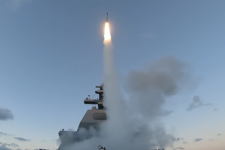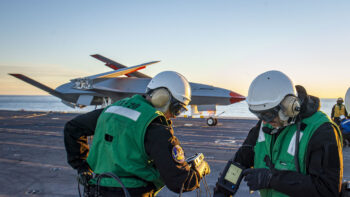
An MQ-9 Reaper with three Ghost Reaper pods attached awaits takeoff at Hancock Field Air National Guard Base, Syracuse, New York.
WASHINGTON: Upgrades to the MQ-9 Reaper’s comms and targeting capabilities are being demo’d by the Air National Guard (ANG) during the Northern Edge 2021 exercise in the Arctic, with a goal to help the venerable drone “play an increased, more prominent role in the command and control arena of the battlefield.”
The new pod-based capabilities will be flown onboard a 174TH ATKW MQ-9, according to a May 6 press release from the New York Air National Guard’s 174th Attack Wing.
The MQ-9 will demo “auto-take-off and landing and high-end fight capabilities” during the May 3-14 exercise, led each year by Indo-Pacific Command, a separate April 29 release by the Air Force’s 85th Test and Evaluation Squadron, 53rd Wing.
The ANG upgrades being showcased during Northern Edge are being funded by The National Guard and Reserve Equipment Account, and are specifically aimed at the legacy drones flown by the Guard, the ANG release said. A spokesperson for the ANG was unable to provide more specifics, including the price tag, noting that more information will be released when the exercise is completed.
The upgrades are based on three separate pods, all of which have been being assessed by the ANG under its Ghost Reaper concept, the release said. Prime MQ-9 contractor General Atomics Aeronautical Systems (GA-ASI), in fact, has been working on integration of the pods over the last year. The three are:
- Northrop Grumman’s Freedom Pod, which houses the company’s Freedom Radio gateway system that can connect fourth- and fifth-generation fighters.
- Rosetta Echo Advanced Payloads (REAP) pod made by Ultra Electronics Inc. that connects to ground systems via Link 16; and,
- GA-ASI’s own Centerline Avionics Bay (CAB) that will allow software to be continuously improved, including via the use of artificial intelligence and machine learning.
The ANG demo comes as the active Air Force also is moving ahead with MQ-9 upgrades to extend aircraft life and boost utility in a high-end fight with peer competitors.
Air Force Life Cycle Management Center (AFLCMC) announced April 21 that it is working with GA-ASI on “several fleet enhancement capabilities” to increase the drone’s “effectiveness against near-peer adversary threats” packaged in a new configuration called “MQ-9 Multi-Domain Operation (M2DO) aircraft.” Under the contract, worth $272.3 million, GA-ASI will deliver 19 of the M2DO aircraft, according to colleague John Tirpak.
The service also is “retrofitting a portion of the already fielded MQ-9 fleet to the same M2DO configuration, allowing the Air Force to leverage current fleet numbers to meet future warfighter requirements through the service life of the aircraft,” the release added.
Without providing many specifics, AFLCMC said the improvements will include “retrofits that will mitigate potential jamming,” changes to “increase the electric power” to enable future updates desired by Combatant Commanders, and “upgrades to the electro-optical/infra-red sensor and will expand the types of weapons the platform will be able to carry.”
The two efforts are seemingly unrelated, although that is not quite clear given that Air Force/National Guard public affairs officers were unable to answer requests for clarification today.
What is clear is that the Air Force is trying to figure out how to maintain and bolster the Reaper’s future usefulness, even as the service continues to push divesting itself of some of the fleet — as Chief of Staff Gen. CQ Brown telegraphed back in February. ““I will tell you right now, the MQ-9 is still a very popular platform with the Combatant Commanders,” Brown told reporters. “So, it’s not something we can just walk away from.”
“Over the past year, our engineers have been working hard to demonstrate a variety of advanced capabilities for the MQ-9,” GA-ASI spokesperson C. Mark Brinkley said today. “What we’re seeing now is a lot of different efforts coming together, with a variety of demonstrations and somewhat unrelated efforts, but all of them unified around exploring the future of the aircraft and the massive opportunities that the MQ-9 brings. Some of these efforts are independent of the others, and they really run across all the services.”
He was reluctant (quite understandably) to provide specifics on the two efforts, however. “For specific details on each effort, we have to send you to those folks for details.”
Lockheed wins competition to build next-gen interceptor
The Missile Defense Agency recently accelerated plans to pick a winning vendor, a decision previously planned for next year.


























